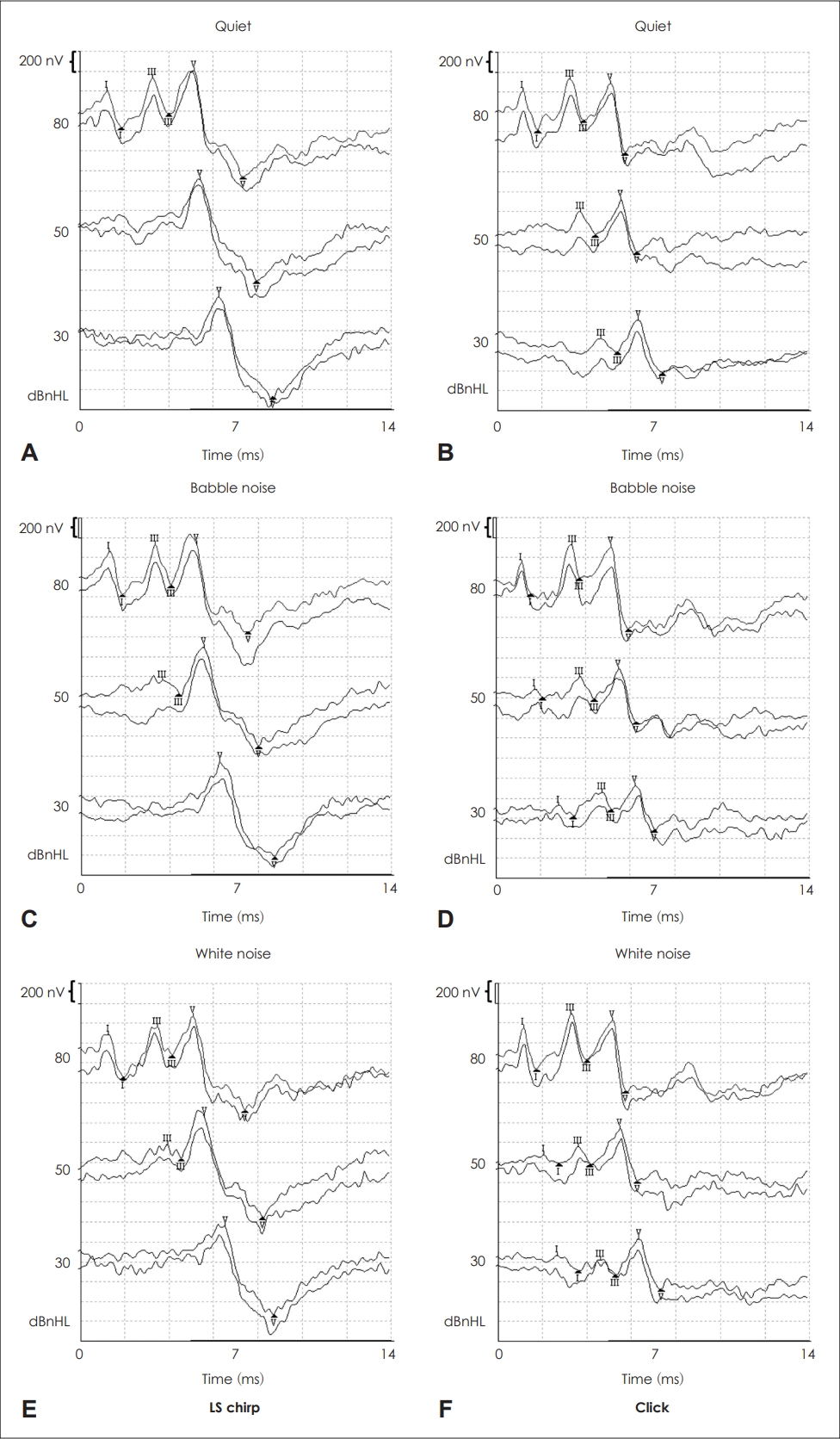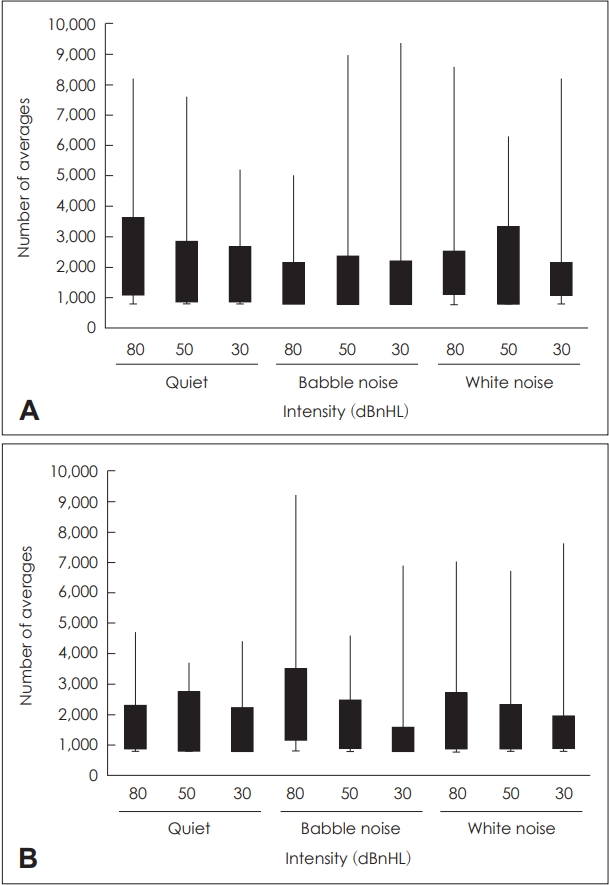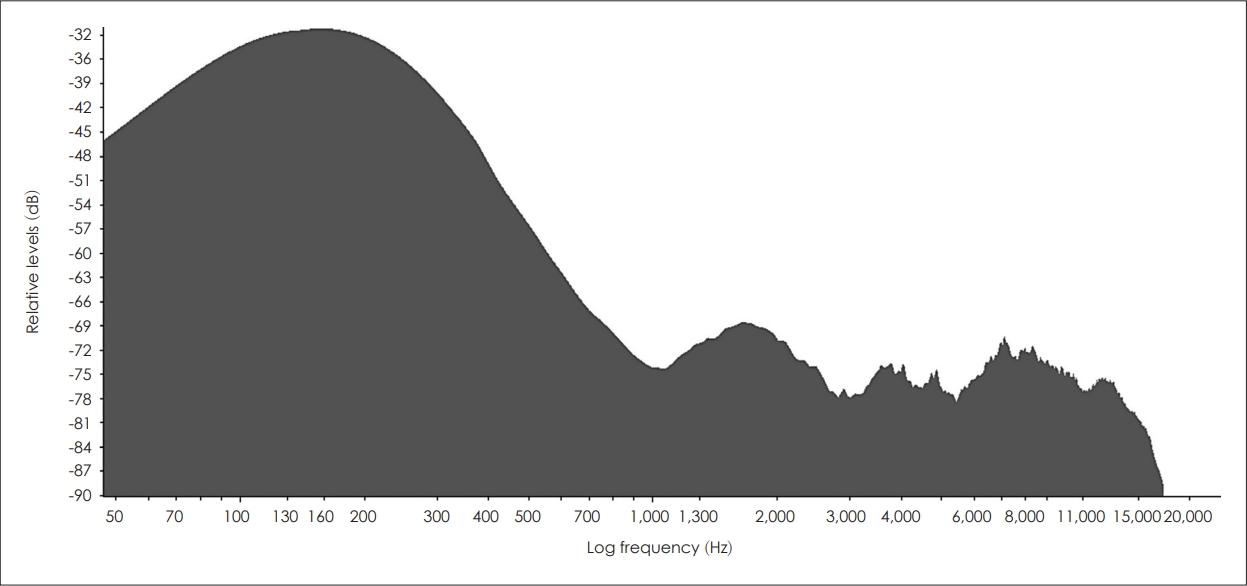2. Hall JW. eHandbook of auditory evoked responses: principles, procedures & protocols. Pretoria: Pearson;2015.
4. Olusanya BO. Ambient noise levels and infant hearing screening programs in developing countries: an observational report. Int J Audiol 2010;49:535–41.


6. Burkard RF, Sims D. A comparison of the effects of broadband masking noise on the auditory brainstem response in young and older adults. Am J Audiol 2002;11:13–22.


7. Kim S, You S, Kim Y, Han W. Establishment of normative data for auditory brainstem responses in white noise condition. Korean J Otorhinolaryngol-Head Neck Surg 2019;63:14–20.


9. Smith S, Kei J, McPherson B, Smyth V. Effects of speech babble on transient evoked otoacoustic emissions in normal-hearing adults. J Am Acad Audiol 2001;12:371–8.


10. Ananthanarayan AK, Gerken GM. Response enhancement and reduction of the auditory brain-stem response in a forward-masking paradigm. Electroencephalogr Clin Neurophysiol 1987;66:427–39.


11. Walton J, Orlando M, Burkard R. Auditory brainstem response forward-masking recovery functions in older humans with normal hearing. Hear Res 1999;127:86–94.


12. Don M, Elberling C. Evaluating residual background noise in human auditory brain-stem responses. J Acoust Soc Am 1994;96(5 Pt 1):2746–57.


13. Elberling C, Don M. Quality estimation of averaged auditory brainstem responses. Scand Audiol 1984;13:187–97.


14. Elberling C, Wahlgreen O. Estimation of auditory brainstem response, ABR, by means of Bayesian inference. Scand Audiol 1985;14:89–96.


15. Kristensen SG, Elberling C. Auditory brainstem responses to level-specific chirps in normal-hearing adults. J Am Acad Audiol 2012;23:712–21.


16. Dau T, Wegner O, Mellert V, Kollmeier B. Auditory brainstem responses with optimized chirp signals compensating basilar-membrane dispersion. J Acoust Soc Am 2000;107:1530–40.


18. Petoe MA, Bradley AP, Wilson WJ. On chirp stimuli and neural synchrony in the suprathreshold auditory brainstem response. J Acoust Soc Am 2010;128:235–46.


20. Dzulkarnain AAA, Abdullah SA, Ruzai MAM, Ibrahim SHMN, Anuar NFA, Rahim EA. Effects of different electrode configurations on the narrow band level-specific CE-Chirp and tone-burst auditory brainstem response at multiple intensity levels and frequencies in subjects with normal hearing. Am J Audiol 2018;27:294–305.


21. Dzulkarnain AAA, Noor Ibrahim SHM, Anuar NFA, Abdullah SA, Tengku Zam Zam TZH, Rahmat S, et al. Influence of two-electrode montages on the level-specific (LS) CE-Chirp auditory brainstem response (ABR) at multiple intensity levels. Int J Audiol 2017;56:723–32.


22. Dzulkarnain AAA, Shahrudin FA, Jamal FN, Marzuki MN, Mazlan MNS. Effects of stimulus repetition rates on the auditory brainstem response to level-specific CE-Chirp in normal-hearing adults. Am J Audiol 2020;29:838–50.


23. Lopes BM, Bueno CD, Didoné DD, Sleifer P. Comparison between click and CE-Chirp® stimuli in neonatal hearing screening. J Hum Growth Dev 2020;30:260–5.


24. American National Standards Institute. American National Standard maximum permissible ambient noise levels for audiometric test rooms (ANSI S3.1-1999). New York: American National Standards Institute;1999.
25. American National Standards Institute. American National Standard specification for audiometers (ANSI S3.6-2004). New York: American National Standards Institute;2004.
26. Hatanaka T, Shuto H, Yasuhara A, Kobayashi Y. Ipsilateral and contralateral recordings of auditory brainstem responses to monaural stimulation. Pediatr Neurol 1988;4:354–7.


27. International Organization for Standardization. Acoustics—Reference zero fro the calibration of audiometric equipment—Part 6: reference threshold of hearing for test signals of short duration (ISO 389-6:2007). Geneva: International Organization for Standardization;2007.
30. Zakaria MN, Zainun Z, Cheu Lih A. Considerations when analyzing vestibular evoked myogenic potential (VEMP) outcomes elicited by chirp stimulus in healthy participants. J Int Adv Otol 2015;11:271–2.















